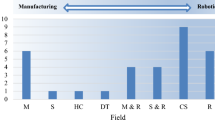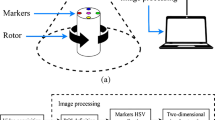Abstract
Wire and arc additive manufacturing (WAAM) has shown promise in recent years for producing large-scale parts with higher deposition rates than other additive processes. WAAM is often combined with subtractive machining to form a hybrid manufacturing process. This hybrid process can be realized by retrofitting computer numerical control (CNC) machines with deposition heads, adding spindles and deposition heads to robots, or developing part localization methods to transfer parts from an additive cell to a CNC machine. Here, a novel, robot-CNC hybrid configuration is introduced where a maneuverable robot is placed in front of a CNC machine to deposit material within the machine envelop. This method removes the need for part localization and the extensive machine modifications required for retrofitting; however, the problem of robot localization is also added. In this work, the effects of error in vision-based, contactless robot localization on machining parameters in a robot-machine hybrid process were studied. Performance was characterized on an implementation of this system using classical computer vision techniques. In addition, machining simulations were conducted to evaluate the effects of image-induced error on chip thickness, material removal rate, and machining allowance. Initial tests show that computer vision could adequately locate a robot for the hybrid WAAM process within .5 mm.

























Similar content being viewed by others
Data availability
All data is available upon request to the corresponding author
References
Singh SR, Khanna P (2021) Wire arc additive manufacturing (WAAM) A new process to shape engineering materials. Mater Today Proc 44:118–128. https://doi.org/10.1016/j.matpr.2020.08.030. https://www.sciencedirect.com/science/article/pii/S2214785320358922
Rodrigues TA, Duarte V, Miranda RM et al (2019) Current status and perspectives on wire and arc additive manufacturing (WAAM). Materials 12(7):1121. https://doi.org/10.3390/ma12071121. https://www.mdpi.com/1996-1944/12/7/1121, number: 7 Publisher: Multidisciplinary Digital Publishing Institute
Flynn JM, Shokrani A, Newman ST et al (2016) Hybrid additive and subtractive machine tools –?research and industrial developments. Int J Mach Tools Manuf 101:79–101. https://doi.org/10.1016/j.ijmachtools.2015.11.007. https://www.sciencedirect.com/science/article/pii/S0890695515300894
Yarrapareddy E, Kovacevic R (2008) Synthesis and characterization of laser-based direct metal deposited nano-particles reinforced surface coatings for industrial slurry erosion applications. Surf Coat Technol 202(10):1951–1965. https://doi.org/10.1016/j.surfcoat.2007.08.032. https://www.sciencedirect.com/science/article/pii/S0257897207008985
He W, Jiang Z, Ming W et al (2021) A critical review for machining positioning based on computer vision. Measurement 184:109,973. https://doi.org/10.1016/j.measurement.2021.109973. https://www.sciencedirect.com/science/article/pii/S0263224121009040
Dinham M, Fang G (2009) A low cost hand-eye calibration method for arc welding robots. In: 2009 IEEE international conference on robotics and biomimetics (ROBIO), pp 1889–1893. https://doi.org/10.1109/ROBIO.2009.5420552
Wu Q, Qin X, Li Y et al (2021) Automatic calibration of work coordinates for robotic wire and arc additive re-manufacturing with a single camera. Int J Adv Manuf Technol 114(9):2577–2589. https://doi.org/10.1007/s00170-021-06664-9
Zhang W, Ma X, Cui L et al (2008) 3 points calibration method of part coordinates for arc welding robot. In: Hutchison D, Kanade T, Kittler J et al (eds) Intelligent robotics and applications, vol 5314. Springer, Berlin, pp 216–224. https://doi.org/10.1007/978-3-540-88513-9_24. series Title: Lecture Notes in Computer Science
Zhang X, Li M, Lim JH et al (2018) Large-scale 3D printing by a team of mobile robots. Autom Constr 95:98–106. https://doi.org/10.1016/j.autcon.2018.08.004. https://www.sciencedirect.com/science/article/pii/S0926580518304011
Shiu Y, Ahmad S (1987) Calibration of wrist-mounted robotic sensors by solving homogeneous transform equations of the form AX=XB. Dep Electr Comput Eng Tech Rep. https://docs.lib.purdue.edu/ecetr/592
Zeng J, Cao GZ, Li WB et al (2019) An algorithm of hand-eye calibration for arc welding robot. In: 2019 16th international conference on ubiquitous robots (UR), pp 1–6. https://doi.org/10.1109/URAI.2019.8768578, iSSN 2325-033X
Tian FP, Feng W, Zhang Q et al (2019) Active camera relocalization from a single reference image without hand-eye calibration. IEEE Trans Pattern Anal Mach Intell 41 (12):2791–2806. https://doi.org/10.1109/TPAMI.2018.2870646. conference Name: IEEE Transactions on Pattern Analysis and Machine Intelligence
Feddema J, Mitchell O (1989) Vision-guided servoing with feature-based trajectory generation (for robots). IEEE Trans Robot Autom 5(5):691–700. https://doi.org/10.1109/70.88086. conference Name: IEEE Transactions on Robotics and Automation
Chang WC (2018) Robotic assembly of smartphone back shells with eye-in-hand visual servoing. Robot Comput Integr Manuf 50:102–113. https://doi.org/10.1016/j.rcim.2017.09.010. https://www.sciencedirect.com/science/article/pii/S073658451630271X
Zhou L, Lin T, Chen SB (2006) Autonomous acquisition of seam coordinates for arc welding robot based on visual servoing. J Intell Robot Syst 47(3):239–255. https://doi.org/10.1007/s10846-006-9078-9. http://link.springer.com/10.1007/s10846-006-9078-9
Oyelola O, Crawforth P, M’Saoubi R et al (2016) Machining of additively manufactured parts implications for surface integrity. Procedia CIRP 45:119–122. https://doi.org/10.1016/j.procir.2016.02.066. https://www.sciencedirect.com/science/article/pii/S2212827116003486
Barath Kumar MD, Manikandan M (2022) Assessment of process, parameters, residual stress mitigation, post treatments and finite element analysis simulations of wire arc additive manufacturing technique. Met Mater Int 28(1):54–111. https://doi.org/10.1007/s12540-021-01015-5
de Oliveira AR, Del Conte EG (2021) Concurrent improvement of surface roughness and residual stress of as-built and aged additively manufactured maraging steel post-processed by milling. Int J Adv Manuf Technol 116(7):2309–2323. https://doi.org/10.1007/s00170-021-07527-z
Fuchs C, Baier D, Semm T et al (2020) Determining the machining allowance for WAAM parts. Prod Eng 14(5):629–637. https://doi.org/10.1007/s11740-020-00982-9
Manogharan G (2014) Hybrid manufacturing analysis of integrating additive and subtractive methods. Ph.D., Carolina State University, United States – North Carolina. https://www.proquest.com/docview/1642719354/abstract/A23FCD218CF2402FPQ/1, iSBN:9781321414097
Li F, Chen S, Shi J et al (2017) Evaluation and optimization of a hybrid manufacturing process combining wire arc additive manufacturing with milling for the fabrication of stiffened panels. Appl Sci 7(12):1233. https://doi.org/10.3390/app7121233. https://www.mdpi.com/2076-3417/7/12/1233, number: 12 Publisher: Multidisciplinary Digital Publishing Institute
Norberto López de Lacalle L, Campa FJ, Lamikiz A (2011) 3 – milling. In: Paulo Davim J (ed) Modern machining technology. Woodhead Publishing, pp 213–303. https://doi.org/10.1533/9780857094940.213https://www.sciencedirect.com/science/article/pii/B9780857090997500034
Chernovol N, Sharma A, Tjahjowidodo T et al (2021) Machinability of wire and arc additive manufactured components. CIRP J Manuf Sci Technol 35:379–389. https://doi.org/10.1016/j.cirpj.2021.06.022. https://www.sciencedirect.com/science/article/pii/S1755581721001140
de Araujo PRM, Lins RG (2020) Computer vision system for workpiece referencing in three-axis machining centers. Int J Adv Manuf Technol 106(5):2007–2020. https://doi.org/10.1007/s00170-019-04626-w
Sharf I, Wolf A, Rubin MB (2010) Arithmetic and geometric solutions for average rigid-body rotation. Mech Mach Theory 45 (9):1239–1251. https://doi.org/10.1016/j.mechmachtheory.2010.05.002. https://www.sciencedirect.com/science/article/pii/S0094114X10000790
De K, Masilamani V (2013) Image sharpness measure for blurred images in frequency domain. Procedia Eng 64:149–158. https://doi.org/10.1016/j.proeng.2013.09.086. https://www.sciencedirect.com/science/article/pii/S1877705813016007
Nguyen L, Buhl J, Bambach M (2020) Continuous Eulerian tool path strategies for wire-arc additive manufacturing of rib-web structures with machine-learning-based adaptive void filling. Addit Manuf 35:101,265. https://doi.org/10.1016/j.addma.2020.101265. https://www.sciencedirect.com/science/article/pii/S2214860420306370
Wahab MNA, Sivadev N, Sundaraj K (2011) Target distance estimation using monocular vision system for mobile robot. In: 2011 IEEE conference on open systems, pp 11–15. https://doi.org/10.1109/ICOS.2011.6079296
Acknowledgements
Thank you to Jaime Berez (Georgia Institute of Technology) for providing a point-cloud fitting software library used in a portion of this research.
Funding
This work was supported by the US Department of Energy DE-EE0008303
Author information
Authors and Affiliations
Contributions
Conceptualization: Jesse Goodwin, Christopher Saldaña. Methodology: Jesse Goodwin. Validation: Jesse Goodwin, Christopher Saldaña. Analysis: Jesse Goodwin. Writing - original draft: Jesse Goodwin. Writing—review and editing: Christopher Saldaña. Funding acquisition: Christopher Saldaña. All authors have read and agreed to the published version of the manuscript.
Corresponding author
Ethics declarations
Ethics approval and consent to participate
Not applicable
Consent for publication
Not applicable
Conflict of interest
The authors declare no competing interests
Additional information
Publisher’s note
Springer Nature remains neutral with regard to jurisdictional claims in published maps and institutional affiliations.
Rights and permissions
Springer Nature or its licensor (e.g. a society or other partner) holds exclusive rights to this article under a publishing agreement with the author(s) or other rightsholder(s); author self-archiving of the accepted manuscript version of this article is solely governed by the terms of such publishing agreement and applicable law.
About this article
Cite this article
Goodwin, J., Saldaña, C. Vision-based localization for cooperative robot-CNC hybrid manufacturing. Int J Adv Manuf Technol 126, 241–258 (2023). https://doi.org/10.1007/s00170-023-11009-9
Received:
Accepted:
Published:
Issue Date:
DOI: https://doi.org/10.1007/s00170-023-11009-9




